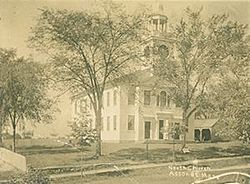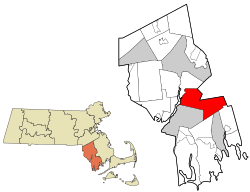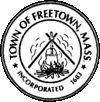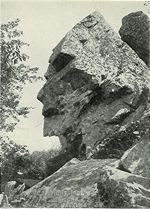Freetown, Massachusetts facts for kids
Quick facts for kids
Freetown, Massachusetts
|
||
|---|---|---|

Historic North Church in Assonet
|
||
|
||

Location in Bristol County in Massachusetts
|
||
| Country | United States | |
| State | Massachusetts | |
| County | Bristol | |
| Settled | 1659 | |
| Incorporated | 1683 | |
| Government | ||
| • Type | Open town meeting | |
| Area | ||
| • Total | 38.3 sq mi (99.2 km2) | |
| • Land | 36.6 sq mi (94.8 km2) | |
| • Water | 1.7 sq mi (4.4 km2) | |
| Elevation | 164 ft (50 m) | |
| Population
(2020)
|
||
| • Total | 9,206 | |
| • Density | 240.4/sq mi (92.80/km2) | |
| Time zone | UTC−5 (Eastern) | |
| • Summer (DST) | UTC−4 (Eastern) | |
| ZIP Codes |
02702, 02717
|
|
| Area code(s) | 508/774 | |
| FIPS code | 25-25240 | |
| GNIS feature ID | 0619434 | |
| Website | www.freetownma.gov | |
Freetown is a town located in Bristol County, Massachusetts, United States. It's a historic place in New England. In 2020, about 9,206 people lived there.
Freetown is one of the oldest communities in the U.S. Pilgrims and their families settled here in the late 1600s. The town once included parts of what are now Fall River and Acushnet. In 1983, Freetown celebrated its 300th birthday!
Today, Freetown has two main parts: Assonet and East Freetown. These areas grew up quite separately. The town is home to the large Freetown-Fall River State Forest and a famous rock formation called Profile Rock. It's about 50 miles (80 km) from Boston.
Freetown is part of the "South Coast" area of Massachusetts. This region includes towns around Buzzards Bay and Mount Hope Bay. The town also has two areas listed on the National Register of Historic Places: the Assonet Village Historic District and the East Freetown Historic District.
Contents
- Discovering Freetown's Past: A Look at Its History
- Exploring Freetown's Geography
- Getting Around Freetown: Transportation
- Learning in Freetown: Education
- Freetown's Population: Demographics
- Freetown's Libraries
- Freetown's Culture and Events
- Media in Freetown
- Places to See in Freetown: Sites of Interest
- Sports and Recreation in Freetown
- Religious Life in Freetown
- Famous People from Freetown
- Books About Freetown
- See also
Discovering Freetown's Past: A Look at Its History
Freetown was first settled by English people on April 2, 1659. They bought the land near the Assonet River from the Wampanoag Indians. This deal was called "Ye Freemen's Purchase." They traded 20 coats, two rugs, and other items for the land.
The settlement slowly grew. It became an official town in July 1683. Freetown was part of the Plymouth Colony until it joined the Massachusetts Bay Colony in 1692. It was the fifth town to be officially formed in Bristol County.
Growth and Change Through the Centuries
Freetown continued to grow in the 1700s. In 1747, the area now known as East Freetown was added. It was bought from Tiverton, Rhode Island.
Townspeople fought in King Philip's War against Native Americans. During the Revolutionary War, a battle took place in Freetown on May 28, 1775. This area is now part of Fall River.
In 1803, Fall River became its own town. Later, in 1815, a part of Freetown was given to Fairhaven, which then controlled Acushnet. That part of East Freetown is still part of Acushnet today.
Freetown was a busy place for industries in the 1700s, 1800s, and early 1900s. There were places that made metal, fishing businesses, textile factories, and other manufacturing. One well-known business was N. R. Davis & Sons, which made guns for the Civil War.
The town's population stayed small, under 2,000 people, until 1950. Since then, it has grown almost five times larger.
Exploring Freetown's Geography
Freetown covers about 38.3 square miles (99.2 km²). Most of this is land, about 36.6 square miles (94.8 km²). The rest, about 1.7 square miles (4.4 km²), is water. The town has an unusual shape. It shares borders with several other towns and cities.
Inside Freetown, you'll find many lakes, streams, and rivers. Important ones include Fall Brook, the Assonet River, and Long Pond. The Native Americans called Long Pond "Lake Apponequet." Freetown also has hills like Breakneck Hill and Joshua's Mountain. Profile Rock is located on Joshua's Mountain. A large part of the Freetown-Fall River State Forest is shared between Freetown and Fall River.
Getting Around Freetown: Transportation
Freetown is easy to reach by major roads. Route 24 (the "Fall River Expressway") has three exits in Assonet. Route 140 (the "New Bedford Expressway") has one exit in East Freetown. Assonet is also on Route 79, and East Freetown is on Route 18.
Public Transport and Airports
The Massachusetts Bay Transportation Authority (MBTA) offers commuter train service nearby. You can catch a train in Lakeville, which is right next to Freetown. There are plans to extend this train service to Fall River, passing through Assonet.
For air travel, smaller airports are in nearby East Taunton and Berkley. The regional airport in New Bedford is also close. If you need a larger airport, T.F. Green Airport in Rhode Island is about 35 miles (56 km) away. Logan International Airport in Boston is about 50 miles (80 km) from Freetown.
Learning in Freetown: Education
Freetown provides schooling for younger students and high schoolers. There are no colleges or universities directly in the town.
Elementary and Middle Schools
In the past, Freetown had small, one-room schoolhouses. After World War II, the town built Freetown Elementary School. It opened in 1950 in the center of town. This area now has a park, police station, and fire station.
In the 1950s, Freetown and Lakeville created a regional school district. In 1972, they opened the George R. Austin Middle School for grades 5-8. This school was replaced in 2002 by the Freetown-Lakeville Middle School. The old George R. Austin Middle School is now an intermediate school for grades 4 and 5.
High School Options
Before 1959, Freetown high school students went to schools in other towns like Fall River or New Bedford. In 1955, Freetown and Lakeville decided to build their own regional high school. Apponequet Regional High School opened on September 21, 1959. It serves students from both Freetown and Lakeville for grades 7-12.
Students who want to learn a trade can apply to Bristol-Plymouth Technical High School. Freetown students can also apply to the Bristol County Agricultural High School.
Freetown's Population: Demographics
| Historical population | ||
|---|---|---|
| Year | Pop. | ±% |
| 1688 | 288 | — |
| 1765 | 1,492 | +418.1% |
| 1776 | 1,901 | +27.4% |
| 1790 | 2,202 | +15.8% |
| 1800 | 2,535 | +15.1% |
| 1810 | 1,878 | −25.9% |
| 1820 | 1,863 | −0.8% |
| 1830 | 1,909 | +2.5% |
| 1840 | 1,772 | −7.2% |
| 1850 | 1,615 | −8.9% |
| 1860 | 1,521 | −5.8% |
| 1870 | 1,372 | −9.8% |
| 1880 | 1,329 | −3.1% |
| 1890 | 1,417 | +6.6% |
| 1900 | 1,394 | −1.6% |
| 1910 | 1,471 | +5.5% |
| 1920 | 1,532 | +4.1% |
| 1930 | 1,656 | +8.1% |
| 1940 | 1,584 | −4.3% |
| 1950 | 2,104 | +32.8% |
| 1960 | 3,039 | +44.4% |
| 1970 | 4,270 | +40.5% |
| 1980 | 7,058 | +65.3% |
| 1990 | 8,522 | +20.7% |
| 2000 | 8,472 | −0.6% |
| 2010 | 8,870 | +4.7% |
| 2020 | 9,206 | +3.8% |
| 2023 | 9,290 | +0.9% |
Source: United States Census records and Population Estimates Program data. |
||
In 2000, Freetown had 8,472 people living in 2,932 households. About 36.9% of these households had children under 18. Most households (70.3%) were married couples. The average household had 2.85 people.
The population was spread out by age. About 24.6% were under 18, and 9.1% were 65 or older. The average age was 38 years. For every 100 females, there were about 101 males.
The median income for a household in Freetown was about $68,505. For families, it was about $72,270.
Freetown's Libraries
Freetown opened its first free library on December 10, 1892. Today, each part of town has its own library. The Guildford H. Hathaway Public Library in Assonet has been serving its community since 1895. The James White Memorial Library in East Freetown opened in 1947. It is a privately owned library that is open to the public. In 2008, Freetown spent about $113,681 on its public libraries. This was about $12 for each person.
Freetown's Culture and Events
Both villages in Freetown have rich cultural histories. They host several big events each year. The Strawberry Festival happens every Father's Day. It is put on by the Tuesday Club of Assonet. The East Freetown Congregational Christian Church holds a Chicken Barbecue.
The town also celebrates Fourth of July with a parade and fireworks. The fireworks display takes place over the Assonet River.
Media in Freetown
Freetown has been covered by many newspapers over the years. Some local papers included the Weekly Journal and the Village Voice. Today, news about Freetown is often found in The New Bedford Standard-Times and the Fall River Herald News. The Boston Globe also covers Freetown in its GlobeSouth section.
Because Freetown is in southeastern Massachusetts, people can get TV and radio signals from different areas. You can watch major TV networks from both Boston and Providence, Rhode Island. Radio stations from Boston, Providence, and Cape Cod can also be heard.
WLWC-TV, a CW network TV station, has its broadcast tower in East Freetown.
Places to See in Freetown: Sites of Interest
Many interesting places in Freetown are linked to its long history. The Freetown Historical Society Museum in Assonet has many old items and information about the town. It also has a large library for family history research. Several buildings on the museum property show what life was like in Freetown long ago. These include a one-room schoolhouse and a blacksmith shop.
Hathaway Park in Assonet is a public park with a boat ramp on the Assonet River. It's a great spot to watch the Fourth of July fireworks. It's also one of the places where the Strawberry Festival is held. The other festival location is the historic bandstand at the Assonet Four Corners. This bandstand was built in the 1930s.
Profile Rock, located in the Freetown-Fall River State Forest, is a unique rock formation. It looks like a face carved into the granite. Local Wampanoag Indians believe it shows the face of Massasoit, a famous leader. King Philip's Cave, in East Freetown, is said to have been a hiding place for Metacomet (also known as King Philip) during King Philip's War.
Freetown also has public beaches. Porter Pastures in Assonet is on Assonet Bay. Town Beach in East Freetown is on Long Pond. There is also a town harbor on Long Pond.
Sports and Recreation in Freetown
The Freetown Youth Athletic Association helps organize youth baseball programs. This group was formed by combining the Assonet Youth Sports Association and the East Freetown Sports Association. They use three baseball fields in town: K. R. R. in Assonet, and Central Park and Long Pond in East Freetown.
If you like golf, you can visit Lazy A Driving Range in East Freetown. It's a place where you can practice your golf swing.
Religious Life in Freetown
Freetown has a history of Christian and Quaker faiths. Today, both parts of town have their own Roman Catholic churches. There is also a United Church of Christ church in Assonet. East Freetown has a variety of other Christian churches. For more details, you can look at the articles for Assonet and East Freetown.
Famous People from Freetown
One Massachusetts governor, Marcus Morton, was from Freetown. The town has also been home to several people who served in the General Court, which is the state's legislature.
| Resident | Residence | Born | Died | Notoriety | |
|---|---|---|---|---|---|
| William Rounseville Alger |  |
1822 | 1905 | A minister, writer, editor, and someone who worked to end slavery. | |
| John M. Deane |  |
Assonet | 1840 | 1914 | A soldier during the Civil War who received the Medal of Honor. |
| Thomas Gilbert | Assonet | 1715 | 1797 | A colonial soldier and a leader for the British side during the Revolutionary War. | |
| Marcus Morton |  |
East Freetown | 1784 | 1864 | Served as Governor of Massachusetts multiple times. A hospital in Taunton is named after him. |
| Ebenezer W. Peirce |  |
Assonet | 1822 | 1902 | A military officer during the Civil War. |
| Dave Rezendes | Assonet | 1959 | A professional NASCAR race car driver. | ||
| Casey Patrick Tebo | East Freetown | 1974 | A filmmaker who has won an Emmy Award. | ||
Books About Freetown
- A History of the Town of Freetown, Massachusetts with an Account of the Old Home Festival, July 30, 1902. Assonet Village Improvement Society (1902)
- A Lexicon History of Freetown, Massachusetts. Earl William Rogers, II. (1973).
- Freetown in the Revolution. David T. Sullivan (1974)
- Freetown: A Tri-Centennial Sampler. Earl William Rogers, II and Mark Andrew Ashton (1983)
- Vital Records of the Town of Freetown, Massachusetts, 1686 Through 1890. Helen Gurney Thomas (1988) ISBN: 1-55613-136-4
- Civil War Diaries of Major John M. Deane, Medal of Honor Winner, 1861–1865. Freetown Historical Society, Inc. (2005)
- Dark Woods: Cults, Crime and the Paranormal in the Freetown State Forest, Christopher Balzano, Schiffer Books (October 2007)
See also
 In Spanish: Freetown (Massachusetts) para niños
In Spanish: Freetown (Massachusetts) para niños




